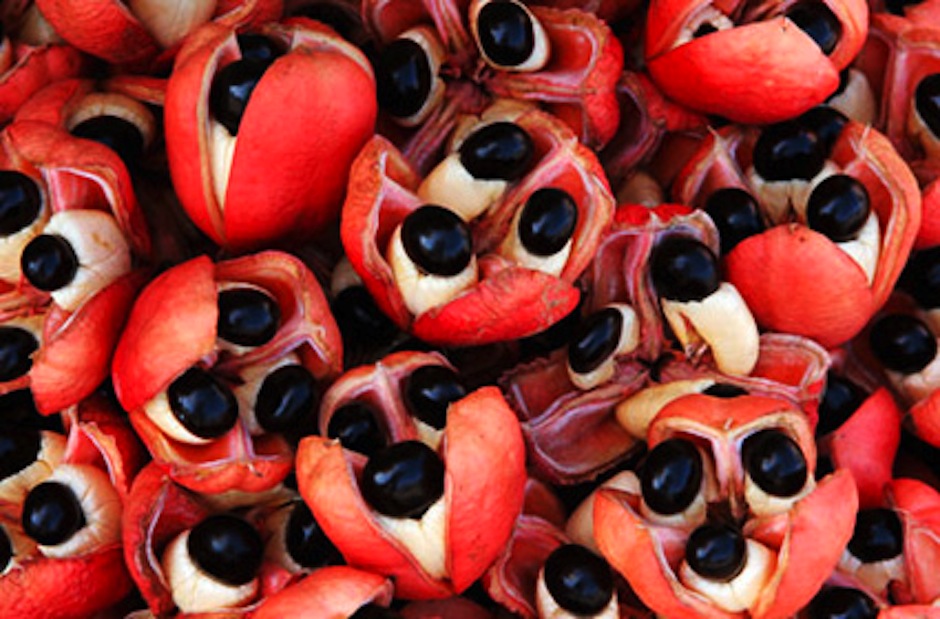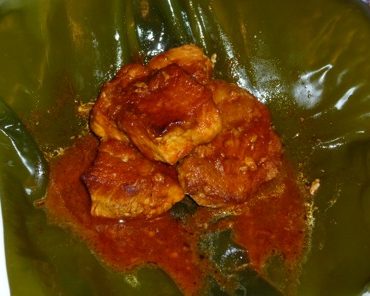
“I shall describe this piece of cookery as the knowledge of it may be useful in the West Indies.” – Captain William Bligh
The great smell of my childhood is the smell of coconut oil in the air of my great grandmother’s house, where my memories begin. Coconut oil’s scent, complex as a scripture, so clings to my brain that it was natural for me, when I had occasion to describe the breath of an angel, to give the divine breath that scent. Recently I’ve learned that coconut oil is full of saturated fat, and therefore, if I know what’s good for me, I will not inscribe its scripture too heavily on my heart.
Still, nothing would please me more than to have a plate of another childhood favorite—ackee and saltfish—cooked in coconut oil and set before me like a Fauve painting come to life with the bright yellow of the ackees enriched by the memory of the uncooked fruit’s big black seeds gleaming out of leathery red pods. Nothing would please me more than to see, mixed with ackee cooked with onions and red bonnet peppers, flakes of a fillet of saltfish—the Jamaican name for dried cod–that has been soaked overnight into softness and properly cooked.[1]
The knowledge that saltfish came all the way from Norway to Jamaica on great ships did not so much stir my child’s imagination as add another ingredient—unidentifiable and necessary as a sprinkle of spiced time—to the meal.
Ackee trees—which as a child pausing under them I thought to be as much in their birthplace as I was–were probably brought over from West Africa on slaveships. One early chronicler of the slave and sugar system in Jamaica asserts that “Aka” is “Another fruit, introduced by Negroes.”[2] So there is grief and death and greed in that dish that I took in like a pure condensation of sun, sea and the power of the women who cooked it for me. In its own way, though, the dish turns grief and death against themselves. Grief and death are cooked out of it, like the poison–hypoglycin A–that immature raw ackees contain.
Driven out of our food by fire, the British empire’s bloody taste nevertheless continues to open obscurely in ackee pods. It opens also in the leaves of another tree I remember from my great grandmother’s yard—the first tree that I ever tried to climb: a small breadfruit tree.
Breadfruit–especially after I moved to an informal foster home after becoming too much for my great grandmother to handle–was something I ate less frequently than ackee. But the name, tasting of Eden, enriched the English language as it grew in my head. Europeans certainly saw it that way. The tree, according to Lord Byron, “bakes its unadulterated loaves/ Without a furnace in unpurchased groves…” As for me, swaddled in ignorance, I took breadfruit–which are “the size and shape of a child’s head,” according to the 18th century British explorer (and Bligh mentor) Captain Cook–for things that had cast shadows on Jamaican dirt since time immemorial.
Not at all: The transit of the breadfruit trees from the South Pacific islands (where Cook first “discovered” it) to Jamaica underscores the fact the island was a vast meal whose ingredients the British gathered but whose actual preparation and seasoning was seized from the Brits by the people of Africa and Asia whom the British collected on the island as one collects chopped vegetables on a cutting board.
Captain William Bligh–immortalized in numerous books and in the Mutiny on the Bountymovies–was granted the original commission to collect Tahiti breadfruit plants for transport to the Windward Islands and Jamaica. The commission came because Bligh’s uncle by marriage, Duncan Campbell, and other owners were casting about for a source of food for slaves being worked (sometimes to death) on their Jamaica sugar plantations. The island’s sugar industry was reeling at the time from a devastating series of natural disasters, and from the loss of a major trading partner when the American colonies broke with England. The result of the natural and political catastrophes was a collapse of food supplies for the slaves on whom Jamaica depended: “the usual attendants of scanty and unwholesome diet, dropsies and epidemic dysenteries, were … soon dreadfully prevalent,” according to Bryan Edwards, author of a 1793 History, Civil and Commerical, of The British Colonies in the West Indies. Edwards asserted that the West Indies “are become the principal source of [Britain’s] Opulence and Maritime Power.” To preserve thisOpulence, breadfruit was settled upon as a sort of tree of life from which the British Empire could eat.[3]
Campbell provided both the ship that became the Bounty, and recommended the captain, Bligh, who was to command it.[4] In the words of the commission given to Bligh, “the king, upon a representation from the merchants and planters interested in his Majesty’s West India possessions … hath, in order to promote the interests of so respectable a body of his subjects (especially in an instance which promises general advantage) thought fit that measures should be taken for the procuring some of those trees….”
Bligh was instructed to “proceed…round Cape Horn, to the Society Islands, situate in the Southern ocean, in the latitude of about eighteen degrees south, and longitude of about two hundred and ten degrees east from Greenwich, where, according to the accounts given by the late Captain Cook [a Bligh mentor], and persons who accompanied him during his voyages, the breadfruit tree is to be found ….”
Following these instructions, Bligh sailed to Tahiti and, over the course of almost six months, succeeded in securing over 1000 young potted breadfruit trees before turning his ship away from Tahiti on April 4, 1789. The mutiny on the Bounty took place on April 28th. The mutineers, led by the 24-year old Fletcher Christian, did not, Bligh speculated, wish to return to British life: “I can only conjecture that the mutineers had assured themselves a more happy life among the [Tahitians] , than they could possibly have in England…The women of [Tahiti] are handsome, mild and cheerful in their manners and conversation….[The mutineers] imagined it in their power to fix themselves in the midst of plenty, on the finest island in the world, where they need not labor, and where the allurements of dissipation are beyond anything that can be conceived….”
Bligh, however, had tyrannical tendencies that–as a man whose career blossomed in the bosom of slavery, a man who, as “an officer and captain in the British Navy of his era … could hardly avoid being haughty and arrogant”[5]–he may not have been entirely aware of. Edward Christian, the brother of the leader of the mutiny, constructed a convincing case that Bligh “was a foul-mouthed, arbitrary, vain perfectionist who consistently drove his men to the very edge of insubordination,” according to R. D. Madison.[6]
All this—the thirst for wealth of Campbell, the thirst for command of Bligh, and, as Madison reports the 19th century saw it, the thirst for freedom of Christian, to say nothing of the will of the Jamaican slaves, who refused to accept breadfruit as a staple[7]— all that is bound up in the breadfruits that grew on the tree in my great grandmother’s yard. All this is bound up, too, in ackee, which was dubbed Blighia sapida in 1806 in honor of Bligh, who undertook a second expedition to Tahiti, and, in 1793, after dropping the long-sought breadfruit saplings off in the West Indies, transported ackee to England for scientific description.[8]
Describing the Bounty mutiny, Bligh wrote that, from the time Fletcher Christian and three others burst into his cabin at the beginning of the uprising on April 28, 1789, until he, Bligh, and 18 others were put off the Bounty into a launch, all his efforts to reassert his authority were met with “hold your tongue… or you are dead this instant,” or words to that effect. In Jamaica, rebel slaves who ran off to form their own Maroon communities surely sometimes issued similar threats.
Less obviously revolutionary is the ability to refuse to eat breadfruit except on one’s own terms, the ability to create a culture in which one can place a slice of breadfruit on a plate of ackee and saltfish, in a kitchen still smelling of Jamaican coconut oil. That too is a discovery of a New World: a new world that can fit on a plate set before a child: a new world that, by its very existence, says “hold your tongue” to the imperial dead.
[1] A recipe for ackee and saltfish can be found at http://www.jamaicatravelandculture.com/food_and_drink/ackee_and_saltfish.htm
[2]Bryan Edwards, Esq. The History, Civil and Commerical, of the British Colonies in the West Indies, vol. 1. London: John Stockdale, Picadilly 1793, 203
[3] Bryan’s remarks on slave mortality are quoted in Dulcie Powell. “The Voyage of the Plant Nursery, H.M.S. Providence, 1791-1793.”Economic Botany 31.4 (Oct.-Dec, 1977), 389; Bryan’s claim about the West Indies appears on the title page of The History, Civil and Commercial, of the West Indies.
[4] Alistair Campbell. A History of Clan Campbell, volume 3 (Edinburgh University Press Ltd 2004), 216
[5] Dulcie Powell. “The Voyage of the Plant Nursery, H.M.S. Providence, 1791-1793,” 392
[6] R. D. Madison. “Introduction,” in William Bligh and Edward Christian. The Bounty Mutiny. New York: Penguin Books 2001, xviii
[7] Ibid, 32-33
[8] Dulcie Powell, 407








